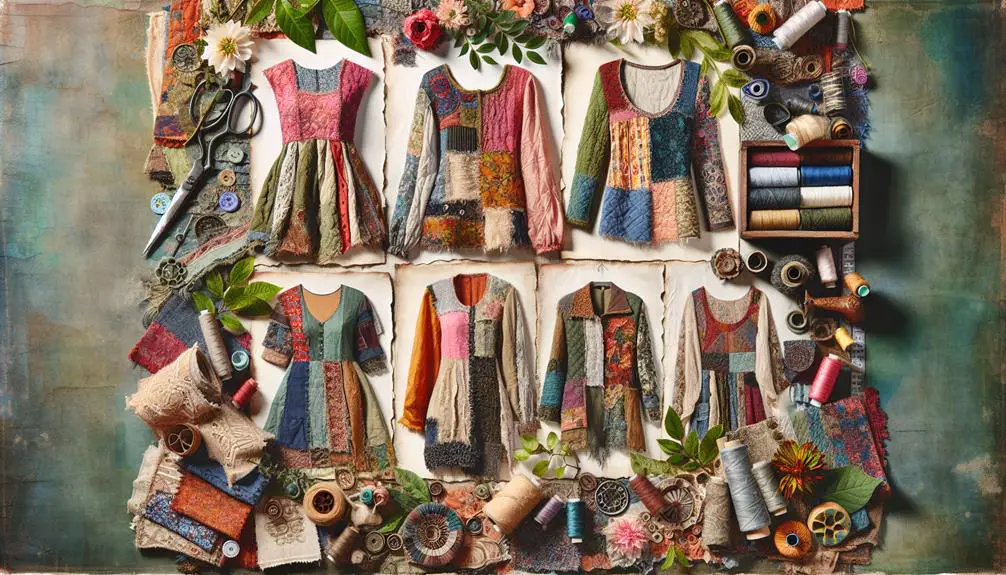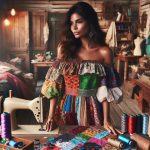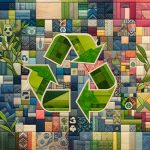You might think upcycled fabrics are just a passing trend, but they offer real, sustainable solutions in fashion. By repurposing materials that would otherwise end up in landfills, you're cutting down on waste and conserving resources. Beyond environmental benefits, upcycled fabrics often carry unique stories and craftsmanship that mass-produced items lack. Curious about how upcycling works or which designers are leading the way? There's a lot more to explore if you're interested in making greener fashion choices while still looking stylish.
Table of Contents
Key Takeaways
- Upcycled fabrics reduce environmental impact by minimizing waste and conserving resources.
- They support the circular economy by repurposing existing textiles, reducing the need for new materials.
- Upcycled materials often have a lower carbon footprint compared to newly produced fabrics.
- Popular techniques like patchwork and dyeing refresh old fabrics creatively and sustainably.
- Ethical brands using upcycled fabrics emphasize fair labor practices and transparent sourcing.
Benefits of Upcycled Fabrics
Have you ever wondered why upcycled fabrics are gaining popularity in the fashion industry? It's because they offer significant benefits that align with the principles of sustainable textiles and the circular economy. By reusing materials that would otherwise go to waste, upcycled fabrics help reduce the environmental footprint of the fashion industry. They minimize the need for new resources and cut down on waste, making them a perfect fit for eco-conscious consumers who prioritize sustainability.
When you choose upcycled fabrics, you're participating in a circular economy. This system aims to keep resources in use for as long as possible, extracting maximum value before recovering and regenerating products and materials at the end of their service life. This approach drastically reduces waste and pollution, essential components for a sustainable future.
Moreover, the fashion industry is increasingly recognizing the importance of catering to eco-conscious consumers. By integrating upcycled fabrics into their designs, brands not only demonstrate a commitment to environmental responsibility but also appeal to a growing market segment that values sustainability.
Popular Upcycling Techniques
When you explore popular upcycling techniques, you'll find patchwork and quilting to be incredibly creative.
Dyeing and painting let you refresh old fabrics with vibrant colors.
Don't forget about embroidery and appliqué, which add intricate designs and personal touches to your projects.
Patchwork and Quilting
Patchwork and quilting transform fabric scraps into beautiful, functional pieces while celebrating creativity and sustainability. By harnessing your imagination and skill, you can create unique creations that stand out as sustainable art. These methods, rooted in traditional techniques, allow you to immerse yourself in new life into old fabrics, combining them in ways that reflect both heritage and modern style.
When you delve into patchwork, you're not just stitching pieces of fabric together; you're weaving a story. Each scrap holds its own history, and as you assemble them, you're crafting a narrative that's uniquely yours.
Quilting, on the other hand, adds texture and depth, turning flat pieces into cozy, tactile masterpieces. The careful layering and stitching not only enhance durability but also bring out intricate patterns that captivate the eye.
Mastering these techniques lets you contribute to a more sustainable world. Instead of discarding worn-out textiles, you're repurposing them into something new and valuable. This practice minimizes waste and promotes mindful consumption. Plus, the satisfaction you'll feel from creating something both beautiful and practical is unparalleled.
Dyeing and Painting
Transform old fabrics into vibrant new pieces by mastering dyeing and painting techniques. With these methods, you can breathe new life into tired textiles, making them uniquely yours. Delve into tie dye techniques to create mesmerizing patterns or explore hand painted fabrics to express intricate designs.
Here's a quick comparison to help you decide which technique to try:
| Technique | Tools Needed | Best For |
|---|---|---|
| Tie Dye | Fabric dyes, rubber bands | Bold, abstract patterns |
| Hand Painting | Fabric paint, brushes | Detailed, personalized designs |
| Shibori | Indigo dye, folding tools | Elegant, traditional motifs |
| Ice Dyeing | Ice, powdered dyes | Unique, watercolor-like effects |
| Batik | Wax, fabric dyes | Detailed, wax-resist patterns |
Tie dye techniques are perfect if you want to achieve bold, abstract patterns that pop with color. Start by twisting and binding sections of your fabric before applying dye. This method is great for beginners looking to make a big impact with minimal effort.
For those aiming for more detailed and personalized designs, hand painted fabrics offer endless possibilities. Use fabric paints and brushes to craft anything from simple motifs to complex artwork. This technique allows you to showcase your artistic skills and create truly one-of-a-kind pieces.
Embroidery and Appliqué
After mastering dyeing and painting techniques, you can further enhance your upcycled fabrics with embroidery and appliqué, adding texture and intricate details to your creations. These techniques aren't just about decoration; they represent sustainable embellishments that transform worn-out or plain fabrics into stunning pieces of art. By incorporating embroidery and appliqué, you engage in creative recycling, breathing new life into old materials.
Embroidery allows you to create detailed patterns and textures with thread, offering endless possibilities for customization. Whether it's intricate floral designs or bold geometric shapes, your eco-conscious designs will stand out.
Appliqué involves stitching smaller pieces of fabric onto a larger one, creating a layered, three-dimensional effect. This method is perfect for utilizing fabric scraps, ensuring nothing goes to waste.
Designers Leading the Way
You'll find that innovative designers are transforming the fashion industry with their creative use of upcycled materials.
They're not just making eco-friendly designs; they're setting new standards for sustainability.
Innovative Material Use
Leading designers are constantly pioneering the use of innovative materials, transforming discarded fabrics into high-fashion masterpieces. You'll be amazed at how they leverage textile innovations to craft creative designs that not only stand out on the runway but also promote sustainability. These trailblazers are setting new fashion trends by reimagining what's possible with materials that would otherwise end up in landfills.
Consider the ingenious use of recycled plastic bottles turned into soft, wearable fabrics. This bold move merges technology with sustainability, pushing the boundaries of what you expect from high-end fashion.
Designers are also experimenting with upcycled denim, turning old jeans into chic jackets and dresses that exude both style and environmental responsibility.
Eco-friendly Design Practices
Many designers are now championing eco-friendly design practices, taking sustainability from mere concept to tangible reality in their collections. By adopting sustainable practices and ethical sourcing, they're transforming the fashion industry. You can see this shift in how they select materials, minimize waste, and guarantee fair labor conditions.
Here's a breakdown of some leading eco-friendly design practices:
| Sustainable Practice | Description |
|---|---|
| Ethical Sourcing | Using materials from suppliers who pay fair wages and practice safe working conditions. |
| Upcycling | Reusing old fabrics to create new, stylish items. |
| Zero-Waste Design | Crafting patterns that utilize nearly every scrap of fabric to minimize waste. |
| Natural Dyes | Opting for plant-based dyes that don't harm the environment. |
| Sustainable Packaging | Using biodegradable or recycled materials for packaging. |
Embracing these practices not only preserves the environment but also sets high standards for the industry. As you explore these designers' collections, you'll notice how they seamlessly blend aesthetics with responsibility. Their commitment to ethical sourcing and sustainable practices guarantees that fashion can be both beautiful and kind to the planet. By supporting these pioneers, you're contributing to a more sustainable future in fashion.
DIY Upcycled Fashion Ideas
Transform your old clothes into trendy, one-of-a-kind pieces with these DIY upcycled fashion ideas. Embrace the art of thrifted transformations and elevate your wardrobe with unique, sustainable garments.
First, let's talk about repurposing denim. Old jeans can be transformed into stylish shorts, skirts, or even bags. Cut off the legs to create distressed shorts or stitch together a chic tote bag. Denim's durability makes it perfect for endless creative ventures.
Next, consider giving a secondhand style a fresh twist. Scour thrift stores for vintage chic finds that can be altered to suit modern tastes. A simple dress can become a statement piece with some creative tailoring or added embellishments like lace or patches.
Here are three exciting ideas to get you started:
- Denim Tote Bags: Cut and sew old jeans into sturdy, fashionable tote bags.
- Patchwork Jackets: Combine fabric scraps to create a colorful, eye-catching jacket.
- Embellished Dresses: Add lace, buttons, or embroidery to vintage dresses for a unique look.
Choosing Quality Materials
When upcycling, prioritize natural fibers like cotton, linen, and wool for their durability and breathability. These materials not only stand the test of time but also offer comfort and versatility.
To guarantee your upcycled garments are truly sustainable, start with fabric sourcing from sustainable suppliers. A reputable supplier guarantees that the fabrics you choose are ethically produced, minimizing environmental impact and supporting fair labor practices.
Focus on material durability when selecting fabrics. High-quality natural fibers tend to wear well over time, reducing the need for frequent replacements. Garments made from these materials can be mended, repurposed, and upcycled multiple times, extending their lifecycle and contributing to a more sustainable wardrobe.
When evaluating fabrics, pay attention to their weight and weave. Heavier fabrics like denim or canvas are ideal for items that need to withstand frequent use, while lighter fabrics like cotton voile or linen are perfect for airy, long-lasting garments.
Always inspect the fabric for any signs of wear or damage before upcycling to secure the finished product will be robust.
Impact on the Environment
Upcycling fabrics reduces the environmental footprint of the fashion industry. When you choose to upcycle, you're directly contributing to a more sustainable future by minimizing waste and conserving resources.
Here's how upcycling positively impacts the environment:
- Reduces Waste: By repurposing existing materials, you help divert tons of textiles from landfills.
- Conserves Resources: Upcycling requires fewer raw materials, meaning less water, energy, and chemicals are used.
- Lowers Carbon Emissions: With less production involved, the carbon footprint of upcycled products is notably smaller.
Your decision to support upcycled fabrics sends a powerful message to the industry. Consumer awareness drives demand for more sustainable practices, pushing brands to adopt more environmentally-friendly methods. As a consumer, you hold the power to influence industry responsibility by choosing products that prioritize the planet's well-being.
Sustainable practices in fashion are no longer optional; they're essential. By understanding the environmental impact of your choices, you become a part of the solution. Each upcycled garment you wear not only reduces waste but also promotes a culture of sustainability and responsibility in fashion.
Embrace upcycling and contribute to a greener, more conscious world.
Supporting Ethical Brands
Supporting ethical brands means making conscious choices that align with your values and promote fair labor practices. When you choose brands dedicated to ethical sourcing and fair trade, you're not just buying a product—you're supporting a movement.
Ethical sourcing safeguards that the materials used are obtained in a responsible and sustainable manner, often involving upcycled fabrics that reduce waste and environmental impact. Fair trade practices assure that workers receive fair wages and work in safe conditions, fostering a more equitable fashion industry.
To master sustainable fashion choices, start by researching brands that prioritize these principles. Look for certifications and transparent supply chains that demonstrate a commitment to ethical practices. Many brands now offer detailed information about their sourcing and manufacturing processes, making it easier for you to make informed decisions.
Future of Upcycled Fashion
Imagine a world where discarded fabrics transform into high-fashion masterpieces, leading the charge toward a more sustainable future. In this visionary landscape, you'll see the rise of the circular economy and sustainable design practices, where waste is minimized, and resources are continually reused.
To deepen your understanding, consider these key points:
- Textile innovation: Cutting-edge technologies will enable the creation of new fabrics from old materials, pushing the boundaries of what's possible in fashion.
- Eco-conscious consumers: As awareness grows, you'll find more individuals demanding transparency and sustainability from their favorite brands.
- Collaborative efforts: Designers, manufacturers, and consumers will work together to create a closed-loop system, ensuring that every piece of fabric has a purpose.
Embracing the future of upcycled fashion means advocating for a shift in how we view and use textiles. You'll witness the fusion of art and sustainability, where every garment tells a story of redemption and creativity.
Frequently Asked Questions
How Can I Identify Upcycled Fabrics When Shopping?
Picture a green leaf in a sea of fast fashion. You can identify upcycled fabrics by looking for eco-friendly options, checking labels for sustainable shopping, and understanding fashion trends while focusing on identifying quality materials.
Are Upcycled Fabric Items More Expensive Than New Ones?
Upcycled fabric items can sometimes be more expensive than new ones. However, when you conduct a cost comparison, consider their positive environmental impact. You're investing in sustainability and reducing waste, which is invaluable.
What Are the Care Instructions for Upcycled Fabric Clothing?
Caring for upcycled fabric is like tending a rare garden. Washing tips? Use cold water and gentle cycles. Storage recommendations? Keep them in a cool, dry place. Treat them with respect, and they'll last beautifully.
Can Upcycled Fabrics Be Used for Professional or Formal Wear?
Yes, you can absolutely use upcycled fabrics for formal occasions and work attire. These materials can be crafted into sophisticated, stylish pieces that not only look professional but also demonstrate your commitment to sustainability.
How Do Upcycled Fabrics Compare in Durability to New Fabrics?
When comparing durability, upcycled fabrics often match or exceed new fabrics due to their robust origins. Upcycled fabric benefits include reduced environmental impact and meeting rising consumer demand for sustainable options, making them a superior choice.
- The Use of Nonwovens in Construction and Civil Engineering - July 11, 2025
- The Use of Nonwovens in Construction and Civil Engineering - July 11, 2025
- The Use of Nonwovens in Construction and Civil Engineering - July 11, 2025







